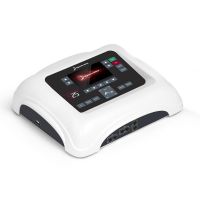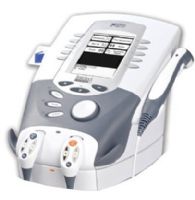 Written by Dr. Eric Wood, ND, MA
Written by Dr. Eric Wood, ND, MA
Since the 1950s, physical therapists have used therapeutic ultrasound to treat conditions like tendonitis and bursitis. In addition to reducing swelling and pain, therapeutic ultrasound devices can speed up the recovery of muscle sprains, scar adhesions, and several other conditions.
The kind of therapeutic ultrasound used will depend on the condition you are trying to treat. Generally speaking, ultrasound therapy is a non-invasive procedure that uses high-frequency sound waves or mechanical vibrations to encourage circulation to an inflamed, injured, or painful body area. Sound waves provide deep heating to tissues and cells within the body.
 | Dynatronics 25 Series Ultrasound Combo with 5 Channel Electrotherapy View Product |
 | Chattanooga Intelect Legend XT Combo System with Electrotherapy and Ultrasound View Product |
In preparation for treatment, ultrasound gel is applied to a transducer to ensure direct skin contact. The transducer releases sound waves with various frequencies to heat or vibrate the underlying structures. If the vibration is used, energy is transferred to the area that is being affected. This energy is believed to break down scar tissue as gas bubbles expand and contract, increasing circulation and promoting healing.
Don’t confuse ultrasound imaging with ultrasound therapy, as the two procedures are very different. An imaging ultrasound uses a transducer to send and receive sound waves to create images of internal body structures. Imaging ultrasound can be used to look at your fetus while pregnant or to diagnose an illness that requires your doctor to examine internal organs.

Thermal ultrasound therapy involves using a vibrating wand to warm the tissue deeply and speed up the healing process. Soft tissue pain, painful overstretching, and other musculoskeletal problems are treated with thermal ultrasound therapy, as well as muscle pain, persistent inflammation, sprains, and strains
Mechanical ultrasound, also known as cavitation ultrasound therapy or non-thermal therapy, creates pressure differences in the affected tissue leading to the formation of bubbles. These tissue-based bubbles expand and contract, and shockwaves are released all around them when they finally burst, promoting quicker healing and pain relief. Mechanical ultrasound therapy is beneficial for helping tissue pass lymph fluid. Because lymph fluid transports white blood cells throughout the body, this therapy is best suited to fight infections and stimulate quicker tissue healing and pain reduction.

An ultrasound transducer is placed on the skin and steadily moved in a stroking motion for approximately 10 minutes, or as determined by your therapist. No needles or incisions are required.
Because this is a non-invasive and painless procedure, there is no need for anesthesia or sedatives. The therapy may be quite relaxing for some.
Both thermal and mechanical ultrasound therapies have therapeutic effects that help pain relief by using heat or vibration to reduce inflammation and improve circulation, enabling faster healing.
Therapeutic ultrasound is safe when used as directed because it is non-invasive and drug-free. In addition, each session lasts for approximately 10 minutes, depending on the size of the area needing treatment.
Conditions affecting the body's soft tissues, such as tendons, muscles, joints, and ligaments, can be treated with ultrasound therapy.
Additionally, ultrasound therapy helps to lessen pain, increase flexibility, and speed up healing by increasing blood flow to injured areas.
A published study reported that several sessions of ultrasound therapy show promise to reduce inflammation, improve grip and finger-pinch strength, and relieve nerve compression both during treatment and six months after treatment.
Ultrasound waves improve tissue flexibility and circulation, which leads to increased mobility and decreased pain.
This condition can benefit from ultrasound therapy because it increases blood flow to muscular knots and tense and painful areas.
Additionally, thermal ultrasound can reduce pain by warming the tissue before a physical therapist applies other treatment modalities.
Both mechanical and thermal ultrasound therapy helps treat symptoms. Deeply penetrating thermal ultrasound heats the muscle tissue, which reduces pain. Contrarily, mechanical ultrasound accelerates healing by enhancing cellular function through cavitation.
Tendons have little blood flow, which enables thermal ultrasound to heat them quickly. Because of this, such treatment can be used successfully in brief intervals to reduce inflammation, stiffness, and pain.
According to apublished research study, ultrasound therapy decreased the healing time by up to 38% in patients with recent bone fractures. Additionally, when a non-union fracture was treated with therapeutic ultrasound, the therapy accelerated the healing by 86%.
Thermal ultrasound therapy sends warmth deep into the tissue to aid in reducing inflammation.
The risk of side effects from ultrasound therapy is minimal. Just don't spend too much time on any one area. The probe must be moved at regular intervals to avoid any thermal damage. Mechanical ultrasound shockwaves can occasionally be uncomfortable, but this is highly uncommon. It is crucial to avoid using therapeutic ultrasound near a pregnant woman's abdomen. As a general rule, avoid the eyes, spine, and any areas that might be home to a pacemaker or metal implant.
Therapeutic ultrasound has been around for decades, consistently relieving users from muscle strains, inflammatory processes, and pain.
As you can see, there are many options for therapeutic ultrasound devices. All of them are effective at providing pain relief and healing. Your ability to recover quickly and effectively is crucial when you have an injury. Ultrasound therapy can help you get better quicker. Take advantage of this beneficial modality today!
Thank you for taking the time to read this article. Keep an eye out for more enlightening and educational content on our Caregiver University platform.

Dr. Wood is a licensed naturopathic doctor in Washington D.C. and founder of Visionary Health. A graduate of the Canadian College of Naturopathic Medicine, Dr. Wood is a professor at John Patrick University in the Integrative and Functional Medicine Department as well as an adjunct professor at the American College of Healthcare Sciences in Holistic Nutrition. He began his career as a specialty physician for two leading supplement US companies, Neuroscience Inc. and Life Extension. Over his fifteen-year career in integrative and holistic medicine, he has worked in diverse capacities including as an educator; writer; medical advisor, consultant and formulator for supplement companies and treatment centers in the US and the EU; public speaker; and clinician. He has long been a practicing advocate of lifestyle medicine, fitness and mind body medicine approaches initially spurred by aging family members not getting help from traditional medicine and is passionate about innovating and bringing natural and integrative medicine to the masses!